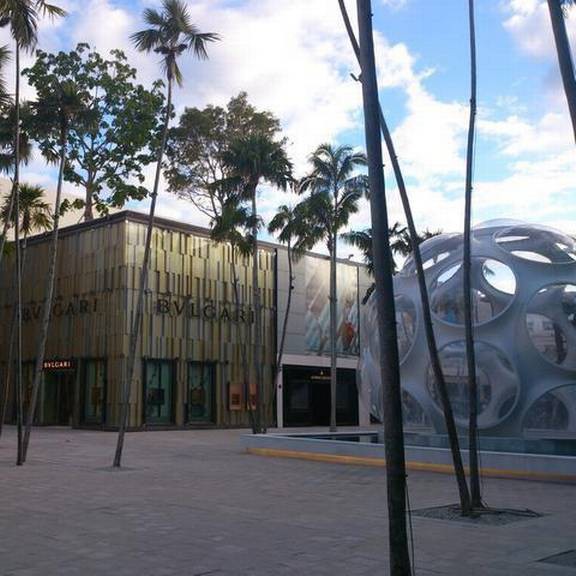Miami Herald

New stores blend culture, commerce in Miami’s Design District
February 5, 2015
As construction in Miami’s Design District proceeds, luxury retailers have begun opening the doors to architecturally splendid boutiques that live up to the shopping area’s name.
More than 40 luxury and fashion brands, from A. Lange & Söhne to Vacheron Constantin, have made the area between Biscayne Boulevard and North Miami Avenue and 38th and 42nd streets their home. Inside are some of the most upscale clothes, shoes, watches, jewelry, handbags and accessories in the fashion cosmos.
“Every week or so another store opens,” said developer Craig Robins, chief executive and president of the Miami-based real estate company Dacra, which has led the transformation of the once run-down neighborhood.
Both outside their storefronts and inside their boutiques, retailers are showcasing unusual and creative architectural components as well as merchandise.
“It’s nothing like Miami has ever seen,” Robins said, comparing the storefronts to those of New York’s famed Fifth Avenue. “The brands all seem to be incredibly inspired to do new and different things. It lends itself to being adventurous.”
One of those brands aiming at “being adventurous” is Tiffany, which is set to open its new boutique on Feb. 6.
The luxury jewelry and specialty retailer will feature works — selected by the company’s design director Francesca Amfitheatrof — from contemporary artists including David Altmejd, Paul Fägerskiöld, Richard Louderback, Thilio Heinzmann and Miami-born Michele Oka Doner. The store will be Tiffany’s first free-standing, street-facing, two-story boutique in the Miami market. Devotees of the jeweler’s Fifth Avenue flagship will find familiar elements, including an abstract interpretation of its famous Atlas figure, designed by Altmejd.
“The reimagined Atlas that’s going to be on the Design District store is going to be so unique,” said Jonathan Bruckner, Tiffany’s market vice president for Florida and Texas. “It really is fitting for the Design District.”
The inside of the store, Bruckner said, will pay homage to Miami’s Art Deco movement, with a massive mural featuring jewel tones and pastels from the historic palette of Miami Art Deco on the back wall, a curved staircase and polished metal walls and faceted mirrors in the second floor salon featuring less expensive fashion jewelry.
In an email, Frederic Cumenal, president of Tiffany & Co., called the new store a “tribute to the vision and creativity of the thriving arts and design community in Miami.”
Other retailers are bringing a similar attention to retail design.
Only a short walk from the Atlas figure, Zegna’s 2,800-square-foot, two-story boutique features an Italian-inspired store design based largely on its global store in Milan. That prototype, developed by architect Peter Marino, features artwork commissioned for the Design District boutique, including a painting by Italian artist Ettore Spalletti.
Inspiration came from Zegna fabric produced at the Zegna family’s wool mill in Trivero, Italy, for more than 100 years, said Gildo Zegna, company CEO, via email.
Around the corner at Valentino, shoppers are greeted by more Italian design infused with Art Deco, courtesy of the company’s creative directors Maria Grazia Chiuri and Pierpaolo Piccioli, and British architect Sir David Chipperfield and his team.
The 4,765-square-foot, two-story boutique, nestled between Louis Vuitton and Van Cleef & Arpels, features a floor in palladiana and walls and portals framed by gray Venetian terrazzo with chips of Carrara marble.
The design emphasizes natural light with a generous, three-story glass facade. It is the only Valentino store to apply the terrazzo both inside and outside, a nod to Miami Beach’s Art Deco scene.
“There’s a real aspiration to include international architecture,” Robins said.
But despite the many international influences, the blooming district reminds Robins of two famous epicenters of American retail.
“The Design District is kind of a combo between the style side of SoHo and the power of Fifth Avenue,” Robins said. “We’re trying to equally experience culture and commerce. Our aspiration is: If someone’s coming to Miami, they have to go see the Design District.”
But will the district’s new wave of unusual designs and experimental architecture translate into more customers and sales?
“It’s still a bit of a work in progress,” said retail consultant Cynthia Cohen, president of Strategic Mindshare. “But it has the potential to be destination shopping.”
Cohen said that other shopping areas like Mary Brickell Village tried the same approach before but failed because they relied on a lot of “small, international retailers.”
“You need attractive stores, but also compelling merchandise,” Cohen said. Big national and international tenants are known commodities that draw customers.
While the area needs to “keep working on urban landscaping,” Cohen said, the mix of galleries and retail makes for a positive, unusual environment.
“They certainly have a geographical advantage,” Cohen said. “In Miami, travel time matters, not distance.”